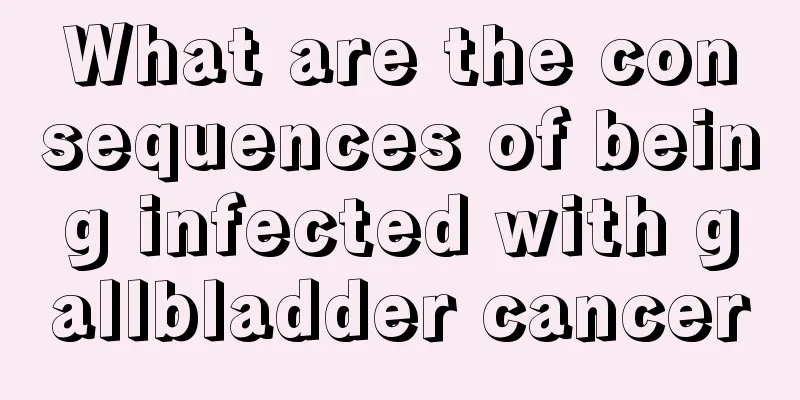What are the consequences of being infected with gallbladder cancer

|
Gallbladder cancer is a malignant tumor that occurs in the gallbladder. For patients with early gallbladder cancer and their families, it is necessary to understand the symptoms of gallbladder cancer early. There are no clinical manifestations of gallbladder cancer in the early stage, or only symptoms of chronic cholecystitis. For this reason, we have introduced the symptoms of early gallbladder cancer in detail. Let’s take a look at the consequences of being infected with gallbladder cancer! Most of the symptoms of gallbladder cancer are persistent pain in the right upper abdomen, which may worsen in paroxysmal ways and radiate to the right shoulder and lower back. Since gallbladder cancer often coexists with gallstones and inflammation, the nature of the pain is similar to that of calculous cholecystitis, starting with discomfort in the right upper abdomen, followed by persistent dull pain or pain, sometimes accompanied by paroxysmal severe pain that radiates to the right shoulder. Most people experience indigestion, aversion to greasy food, belching, and decreased appetite, which is due to the gallbladder's inability to digest fat. Nausea and vomiting are also quite common, and there is often a loss of appetite. Due to the spread of gallbladder cancer, a small number of patients will develop jaundice. Jaundice is the first symptom in a small number of patients, while most patients develop jaundice after pain. Jaundice is persistent and progressive, and a small number of patients show intermittent jaundice. Jaundice often appears in the late stage of the disease, mostly due to cancer tissue invading the bile duct and causing malignant obstruction. It is also accompanied by weight loss, fatigue, and even cachexia, yellowing of the skin and mucous membranes, and difficult-to-treat skin itching. Chills and fever: mostly occur in the late stage of gallbladder cancer. A small number of patients will have fever, and the high fever may persist. Jaundice manifests itself as yellowing of the mucous membranes and skin. Severe jaundice is usually obstructive. Once jaundice occurs, gallbladder cancer is usually in the late stage. A relatively smooth and enlarged gallbladder can be felt in the right upper abdomen. When there is no adhesion to the surrounding tissue, it is highly mobile. When there is adhesion to the surrounding tissue, several lumps can be felt, and sometimes an enlarged liver or a mass of duodenal obstruction can be felt. In nearly half of the cases, a mass can be felt in the gallbladder area in the right upper abdomen at the initial diagnosis. Some parts are hard and have a nodular feel. This mass is the gallbladder. Occasionally, due to obstruction of the cystic duct, the gallbladder may have water accumulation or abscess formation, and tenderness in the gallbladder area and rebound pain may occur. Its signs are very similar to those of acute cholecystitis or obstructive cholangitis. In some cases of gallbladder cancer, metastatic lymph nodes can be felt above the clavicle, and metastatic masses may also appear in the breast, etc. In advanced cases, there may be gastrointestinal bleeding, ascites, and liver failure due to portal vein compression. Most cases of gallbladder cancer present with gradual emaciation, weight loss, fatigue, and cachexia. It is difficult to make a differential diagnosis. Patients with chronic cholecystitis or associated stones, middle-aged people whose recent right upper abdominal pain becomes persistent or progressively worse and have obvious digestive disorder symptoms; especially patients with large single stones, who have recently developed persistent dull pain or pain in the right upper abdomen; patients with a short history of chronic cholecystitis, who have obvious changes in local pain and systemic conditions; patients with gallstones or chronic cholecystitis who have recently developed obstructive jaundice or palpable masses in the right upper abdomen, should all be highly suspected of gallbladder cancer and should undergo further examinations to confirm the diagnosis. Tumors or stones blocking the gallbladder neck can cause gallbladder fluid accumulation, pus accumulation, and gallbladder swelling. This smooth and elastic mass can usually be removed and has a good prognosis. However, hard, nodular, and rough masses are incurable advanced cancers. |
<<: Is gallbladder cancer still contagious after death?
>>: Is gallbladder cancer contagious when it turns into liver cancer?
Recommend
Does advanced lung cancer still require surgery?
Once such changes occur in the late stage, our su...
Is it okay to wash your face with white vinegar every morning and evening?
In order to have smooth and fair skin, you must p...
How many treatments are there for lung cancer?
Lung cancer is a common malignant tumor, and its ...
Can water spinach and kelp be eaten together
Water spinach and kelp can be eaten together, mai...
What does white discharge after urination mean?
Most cases of white urine are caused by chronic p...
Why do I feel itchy all over recently?
Itch is a very uncomfortable feeling. Once the it...
What is the effect of applying cooling oil to the navel
Whether it is men or women, in daily life, diet a...
How to remove the smell of onions?
When it’s time for dinner, we eat some vegetables...
How to make hair hard if it is too soft?
Hair is the most important tissue in the human bo...
Can I eat teething sticks?
Teething sticks are used by infants and young chi...
Can rectal ulcer lead to rectal cancer?
Actively cooperating with the doctor's treatm...
Bone hyperplasia on the instep
The incidence of bone hyperplasia is very high. M...
What should I do if the corner of my eye is swollen?
The corner of the eye is swollen. This is usually...
Does soil have an anti-inflammatory effect on wounds?
Bumps and bruises are inevitable in life, which c...
How to beat egg whites into cream
Whipping egg whites is a common method for making...









